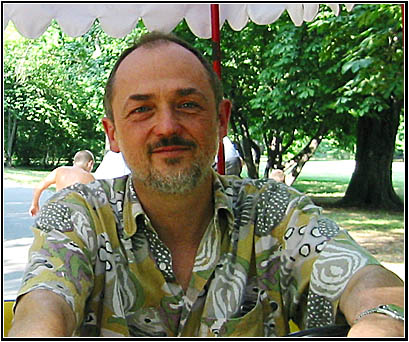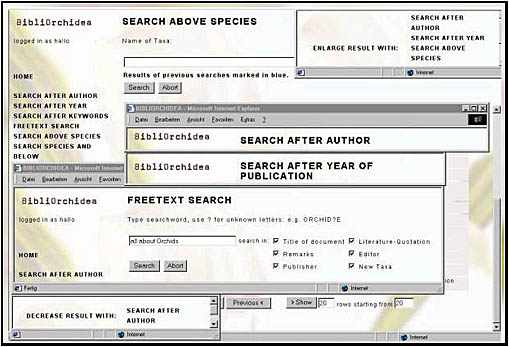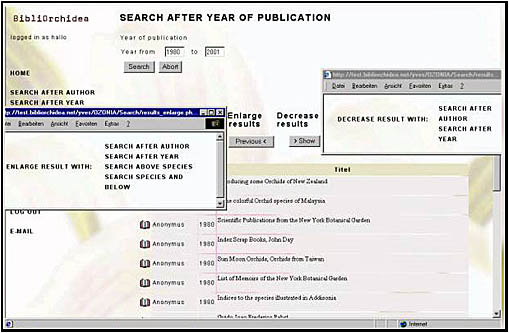|
Bibliorchidea
|
Rudolf
Jenny,
chemist by training, working with Orchids since more than 30 years,
especially interested and active in the subtribes Pleurothallidinae,
Catasetinae and Stanhopeinae.
Author of monographs of Gongora, Sievekingia and
Stanhopea.
Author of the worldwide most comprehensive database about Orchid
literature Bibliorchidea.
|
|
 |
ON: What is exactly
Bibliorchidea?
RJ: It is a database about orchid literature in
all its aspects, providing a fast and actual access to books and articles
about or in connection with Orchidaceae. Special emphasis was given
to taxonomy and systematics. Because of copyright regulations Bibliorchidea
is a collection of citations only, together with a extensive list of
keywords based on the “hard-copy” of the publication in
one of the most complete orchid literature collections worldwide. For
the people maintaining the database it is important to know what the
potential user needs. Also in this case the spectrum is very broad,
from a simple search for the correct spelling of a certain epithet to
a search for literature as basis for a monograph or dissertation almost
everything is possible. The structure of the database should ensure
that questions from allover this area can be answered. Because no database
is complete, it cannot be expected to get a complete list of publications
about a certain issue, but the list has to be complete enough for a
start.
ON: Why Bibliorchidea?
RJ: Literature is still playing a major role in
science and research, on one side because it is a documentation of research
already done and a demonstration of the results. On the other hand it
is also a record about recent research. At least for the time being,
literature search is a part of any scientific work or project. Whoever
has done literature search knows about the difficulties to reach an
overview of the literature in connection with a project in an acceptable
time and with acceptable effort. Computer technology today provides
us with a large selection of very helpful tools to limit time and effort
for literature search.
ON: What kind of document does it concerne?
RJ: As explained above, literature still plays
a very important role in science. In this context the term literature
should not be defined too narrow, we have to accept a very broad collection
of publications as literature. In botany – and in orchideology
as a division of botany – we find, general scientific periodicals,
occasionally with articles about orchids, scientific periodicals in
the botanical field, occasionally with articles about orchids, orchid
periodicals, with at least partially scientific content, society publications
(Orchid Societies), dissertations, general floras or orchid floras,
proceedings, abstracts and reports of congresses and symposiums, catalogues
of all kind, travel and expedition reports, textbooks and basic research
publications, bibliographies and Biographies, correspondence and letters
ON: How long have you been working in this project?
RJ: It has been developed over a period of about
15 years.
ON: Is the Bibliorchidea accessible through internet?
RJ: Yes, the actual form of Bibliorchidea as it
is accessible through internet (http://www.Bibliorchidea.net).
ON: Which is the method or the methods to do search on it?
RJ: You can use different kinds of search and
also combinations of different search methods such as direct search
for author and co-author, for the year of publication, for new descriptions
in the respective fields, for keywords by direct selection from the
keyword catalogue as single keyword or in connection with other keywords
by using the connecting terms and / or (Boolean connections).
You can also enlarge the result by using one of the above mentioned
methods. Besides the search mechanisms, the software naturally allows
the sorting of results by different criterions and the printout as list
of documents or as single document with all the detailed information.
Another possibility is the compilation of a cumulative index of a periodical.
The actual version of the database Bibliorchidea allows institutional
users also to build up an own database with Bibliorchidea as basis.
Electronic lists of collections of specimens (herbariums), of illustrations
(judging) or even a collection of scanned publications are possible
without spending too much time for the fundamentals. According to the
very fast technological development especially in the information technology
it is extremely difficult to guess what development a database like
Bibliorchidea will see in the next years.
ON: Which is the audience for Bibliorchidea?
RJ: Certainly Bibliorchidea will remain a most
important tool for everybody who need orchid literature for profession
or hobby. The important addition is the fact that all documents the
user can find in Bibliorchidea are also available as physical copy,
hence a very fast access is guaranteed.
ON: Would you say that it is complete?
RJ: Naturally also Bibliorchidea is not complete
and there is much doubt whether it ever will reach completeness, but
it will grow continuously. Today it contains more than 125,000 documents,
included in this number are articles from all kind of periodicals, books
or „single publications“, catalogues, dissertations, checklists,
manuscripts and iconographies. All these documents, as far as they have
been published, are included in a form with enough information to order
them through a public or scientific library. One of the hopes for the
future is that authors all around the world would realize that the best
way to make their own publications known would be to send us a copy
in order to add it to Bibliorchidea as fast as possible. This is especially
important for publications which are not widely distributed, like dissertations.
| |
 |
| |
 |
ON: Thank you, Rudolf Jenny.
|
Any
kind of reproduction (print, digital or anyone other) of any
type of material of this site - texts, layout, photos, images
and others - is strictly forbidden without previous written
permission by the authors.
|

|